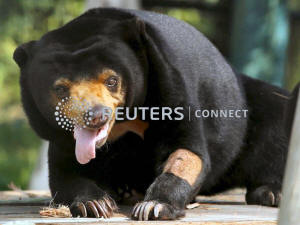|
Little sun bear's facial mimicry reveals
complex social skills
 Send a link to a friend
Send a link to a friend
 [March 23, 2019]
By Will Dunham [March 23, 2019]
By Will Dunham
WASHINGTON (Reuters) - Sun bears, the
smallest of the world's eight bear species, are generally solitary
animals, content to spend most of their time alone outside mating
season, foraging for fruit, rodents, birds and insects in Southeast
Asian tropical forests.
But, scientists said on Thursday, they also possess an unexpected social
skill that puts them in elite company alongside humans and some of our
close evolutionary cousins: the ability to mimic another bear's facial
expressions in a subtle type of communication.
Researchers studied 22 sun bears in spontaneous social play at the
Bornean Sun Bear Conservation Center in Malaysia in outdoor forest
enclosures big enough to let the animals decide whether to interact or
avoid each other all day.
The bears exactly mimicked facial expressions they saw other bears
produce during social play, copying with high precision not only the
type of expression but also specific muscular movements such as raising
their noses and wrinkling the bridge of their muzzles.

Other than people, facial mimicry has been observed in gorillas,
orangutans, two monkey species and domesticated dogs. Until now, only
gorillas had been observed showing a degree of precision comparable to
the complex facial mimicry of people. But the sun bears proved equally
as sophisticated as the gorillas and comparable to people, the study
found.
The findings were surprising not only because sun bears are usually
solitary but also because they are not closely related to humans.
[to top of second column]
|

A sun bear is seen inside a semi-natural enclosure at a bear rescue
center in Tam Dao national park, north of Hanoi, Vietnam, July 22,
2015. REUTERS/Nguyen Huy Kham/File Photo

"It seems that some forms of communication are much more widely
shared amongst mammalian species than we previously thought," said
Derry Taylor, a comparative psychology PhD student at the University
of Portsmouth in England and lead author of the study published in
the journal Scientific Reports.
Sun bears, with a black coat and a white or golden patch on the
chest, are stocky arboreal omnivores reaching about 4-1/2 feet (1.4
meters) long and 145 pounds (65 kg).
Though they favor solitude in the wild, the bears in the study often
engaged in gentle play, with slow grappling actions, and, less
often, rough play, with faster actions and behaviors such as hitting
and biting. A key difference in the two distinct expressions that
the bears mimicked was that one did not display the upper incisor
teeth while the other did.
It remains uncertain what messages the bears were conveying to one
another, but the mimicry might signal a readiness to transition from
gentle to rougher play, Taylor said.
(Reporting by Will Dunham; Editing by Sandra Maler)
[© 2019 Thomson Reuters. All rights
reserved.]
Copyright 2019 Reuters. All rights reserved. This material may not be published,
broadcast, rewritten or redistributed.
Thompson Reuters is solely responsible for this content. |